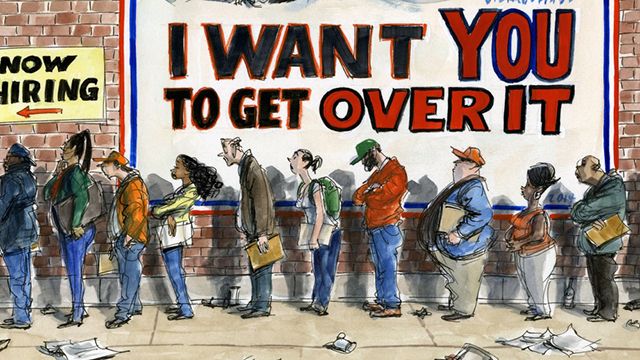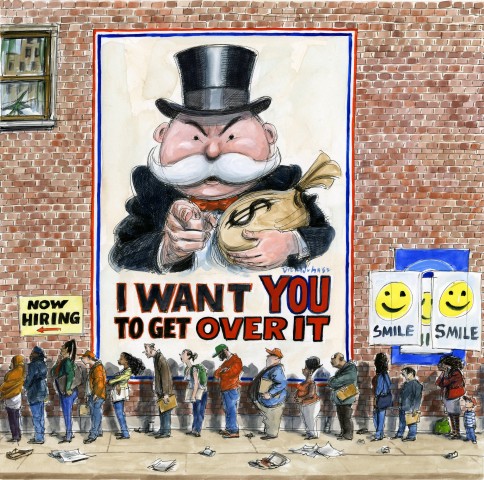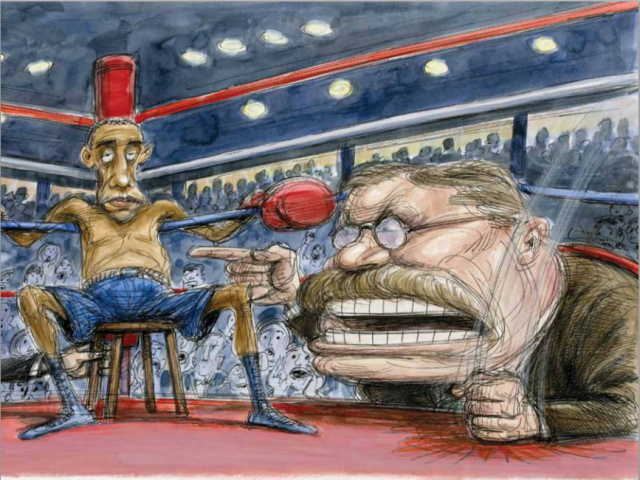
This post first appeared at The American Prospect.
For most Americans, the central economic fact of the past four decades is the stagnation and decline of earnings. Yet this shift is not the central political fact. Why hasn’t the system’s brutal turn against the working and middle class risen to a first-tier public issue?
The raw material is surely there. Americans are far from satisfied with the deal they are getting. Polls show that large majorities believe that the top 1 percent takes too much, that the income distribution is too unequal, that their children are likely to be worse off than they are, that job security is precarious and that the middle class is at risk.
Two big factors prevent these issues from assuming center stage. First, the public is increasingly skeptical that government can do much to change things for the better. The sense of resignation and cynicism plays to the ideology of Republicans — the claim that government doesn’t have a big part to play in the economy and that we’re all on our own. Conversely, resignation harms Democrats, whose core ideology is that government exists to help ordinary people. Republicans have done their best to prevent Democrats from delivering on the vision of activist government.
Second, persistent divisions of race as well as a nativist backlash against immigrants undermine a common politics of uplift for working Americans generally. The New Deal/Great Society formula of tax, spend, benefit and elect has been sundered by stagnation of working-class earnings and fears that government aid would only go to “them” — the undeserving poor. That fear explains much of the opposition to the Affordable Care Act. It sheds light on why victims of the subprime bust were not the objects of broad public sympathy. Racial division has been the standard Republican playbook since Nixon’s Southern Strategy, intensified by Ronald Reagan and redoubled by the tea party. The more that working families are economically stressed, the less help that government delivers, and the more the tax burden tilts away from the top, the more credibility the right has.
In recent years, with Republicans intensifying their strategy of total blockade, the Obama administration’s economic policies have been reduced mostly to a politics of gesture. Increases in the minimum wage, modest educational reforms, orders for the Labor Department to crack down on overtime abuses, tweaks to the tax structure — such policies will help around the edges but not transform the structure of an economy that delivers increasing inequality and insecurity. The Affordable Care Act, a legislative success that was more than a gesture, was so bungled in its execution that, on balance, it raised more doubts about the place of affirmative government and its steward, the Democrats. The 2009 stimulus was a limited success, but it was too small to alter the deeper dynamics of the economy.
How to break out of this vicious circle? How to make the economic plight of working families the core concern that it ought to be? How to restore constructive government to a leading role in that project? The obstacles to reclaiming a fairer society have little to do with immutable characteristics of the new, global, digital economy. They are mainly political.
Learning from the Good War
One vivid, positive experience in our collective memory suggests how the economy could be drastically different. World War II, even more than the New Deal, profoundly altered the economy in ways that generated a more equal society, with more opportunity and security, than the one we have today. These structural changes reinforced one another and affirmed government as friend of the common person.
The war was, first, a massive macroeconomic stimulus. Unemployment was still more than 14 percent in 1940. Thanks to more than $100 billion of war-production orders in the first six months of 1942 — more than the entire gross domestic product of 1939 — joblessness vanished. The war also recapitalized industry that had languished during the Great Depression, and it gave government a central place in developing science and technology. The war was not just a huge jobs program but an unprecedented job-training program. President Franklin Roosevelt also chose to use war production to increase the power of unions as full social partners. A company that wanted defense contracts had to recognize its unions. So the war transformed labor markets.
Second, the war altered incomes. Steeply progressive income taxes with marginal rates as high as 94 percent, limits on executive compensation and strict controls on the bond market led to a compression of the income distribution that lasted more than a quarter-century. The need to finance the war led to emergency measures pegging the rate on government bonds at a maximum of 2.5 percent. The Federal Reserve simply bought whatever quantity of bonds the war effort required. This meant that a major category of financial industry profit — buying, selling and speculating in Treasury bonds — was eliminated, at the expense of the rentier class. Economists even have a name for this process: repression of finance. We could use some of that today.
A side effect of the Good War was enhanced social solidarity, which in turn reinforced political support for egalitarian policies. On the home front, people from diverse walks of life joined in scrap drives, served together as civil defense wardens and waited in line together for ration coupons. A famous survey showed that white soldiers who served together in units with blacks came out less prejudiced than ones who had not. Much of the enhanced propensity for civic action that social scientists such as Robert Putnam and Theda Skocpol have found in the generation born in the 1920s and 1930s was the result of their wartime experience.
All of these structural and attitudinal shifts did not abruptly end in 1945 with V-E and V-J day. They had a long half-life and continued to contour the American economy for at least another generation. To a far greater degree than is understood, the broadly shared prosperity of the postwar boom was a child of the war. It’s also important to appreciate that many of these shifts reflected not fortuitous side effects but deliberate political choices. Franklin Roosevelt could have made war-production planning mainly a business responsibility as Woodrow Wilson had in World War I, but he chose to make it a substantially public affair. He did not have to use defense contracting to strengthen the labor movement, but he chose to. Wilson, in World War I, did nothing to help organized labor.
Thanks for the history lesson, you might say, but what does all this have to do with the present-day economy? Thomas Piketty, in one of the year’s most celebrated economics books, Capital in the Twenty-First Century, demonstrates that the tendency of wealth to concentrate is an inherent characteristic of a capitalist economy. But, Piketty adds in passing, the exception is national emergencies such as wars.
Today, we do not have a war, but we do have an existential emergency of climate change. The risks of disastrous floods, droughts, extreme weather and new forms of pestilence are compounded by the dismal condition of our infrastructure. A program of public investment aimed at resilience as well as a green transition could produce many of the same distributive benefits as the Good War. It could restore a sense of our common fate as Americans and reclaim faith in democratic government. That, of course, will take far more political leadership than we’ve seen lately.

(Illustration: Victor Juhasz)
Bad Advice from Economists
Much of the sense of mass resignation is reinforced by the mainstream of the economics profession. It was Lawrence Summers, then President Barack Obama’s chief economic adviser, who called for a smaller rather than larger economic stimulus in early 2009, urged a bailout rather than a restructuring of Wall Street, and then promoted the president’s disastrous turn to austerity economics in 2010.
We also hear from many leading economists and pundits that today’s widening extremes reflect irrevocable trends in capitalism and that the best we can do is strive for a better-educated population. Thomas Friedman famously wrote in The World Is Flat that when he was a child, his parents used to tell him to finish his dinner and to think of the hungry children in China, adding, “I am now telling my own daughters, ‘Girls, finish your homework — people in China and India are starving for your jobs.’” Friedman did not explain how his daughters, even if they received straight “A”s for their homework, might compete with Chinese wages.
Mainstream economists offer a few basic stories about what accounts for the failure of the economy to generate broadly shared prosperity. The leading candidates include technology, increasing rewards to skills not possessed by ordinary workers; a long-term shift in the share of income going to capital as opposed to labor; “winner take all” effects that deliver super-rewards to entrepreneurial and entertainment superstars; and the inevitable consequences of a globalization that otherwise adds to the economy’s efficiency. The subtext of all of these overlapping accounts is that there’s not much we can do other than improve our schools.
One of the most persistent claims is that the economy is rewarding skills more intensively now than in years past. This is espoused by such prestigious economists as Massachusetts Institute of Technology’s David Autor, who also call for more education as the remedy. The trouble with this view is that there is no good evidence that the economy is demanding skills at a rate above historic trends. Other moderately liberal economists, such as Harvard’s Lawrence Katz and Claudia Goldin, in their book The Race between Education and Technology, contend that we can solve much of the income-distribution problem with enough education. Lawrence Mishel of the Economic Policy Institute counters that the timing of recent trends contradicts the education and technology account. The very period of most intensified growth of the digital economy, the middle and late 1990s, was one of increasing equality, because it was also a period of full employment. Macroeconomic factors turn out to be more important in raising earnings, as they were during World War II. If jobs exist, people will be trained to take them.
As Paul Krugman has pointed out, a true skills shortage describes only a small fraction of the labor market. There are good reasons to have a better-educated and -trained citizenry and to turn out more graduates in math and the sciences. But that remedy by itself will not solve the problem of inequality or stagnant wages for the vast majority. Some of our most highly skilled citizens were the Wall Street fraudsters who crashed the economy. Many highly skilled professionals have difficulty finding decent employment, and increasing numbers of college students are performing jobs that only require a high-school diploma.
Summers gave an influential presentation late last year in which he suggested that the economy is vulnerable to financial bubbles and excessive consumer borrowing to sustain demand because it is not structurally capable of growing fast enough to generate adequate jobs. The economist’s term for this disease is secular stagnation. That was the sort of argument made in the late 1930s, until the wartime spending demonstrated otherwise.
A number of influential economists blame machines. In their recent and well-reviewed book, The Second Machine Age, MIT economists Erik Brynjolfsson and Andrew McAfee describe how digital machines are displacing people at an accelerating rate. But machines have displaced people throughout the history of industrial capitalism. The practical policy question is how the fruits of all that new productivity are to be distributed. Like others, these authors call mainly for more and better education, but they do suggest some useful redistributive mechanisms such as a national mutual fund, more investment in infrastructure, government jobs programs and vouchers for basic necessities.
A far more plausible account, told by such economists as David Weil of Brown University, David Howell of The New School and legal scholar Katherine V. Stone of the University of California, Los Angeles, law school is that the labor-market institutions of the postwar era, which defended the labor share of the total national income, have been drastically weakened, with predictable results. A companion trend is the liberation of financial capital from the salutary shackles of the war and postwar period, giving super-elites the ability to capture far more of the social product than they in any sense earn.
It’s true that the globalization of manufacturing and the use of far-flung supply chains reaching into low-wage countries widen income inequality at home. But there is more than one brand of globalization. We could just as well have a version with decent labor and social standards. One of the effects of World War II was that America was able to emphasize domestic production and rebuilding without being charged with the sin of protectionism.
Tinkering with education and training or even a higher minimum wage will not restore good earnings for the working and middle class. But the wartime experience demonstrates that a different structure of a capitalist economy, rooted in public investment and full employment, is possible. The current failure to spread productivity gains has little to do with technology, skills or even globalization — and everything to do with our failure to constrain great private wealth, empower labor and creatively use democratic government for national purposes.

(Illustration: Victor Juhasz)
Leadership Lessons from the Roosevelts
For many of us, the history of modern liberalism begins with Franklin Roosevelt. In fact, it begins with his Republican fifth cousin, Teddy. As Doris Kearns Goodwin points out in her recent book, The Bully Pulpit, Theodore Roosevelt was the first president to use activist government as a vigorous instrument of the collective good and a counterforce to constrain the power of financial elites.
Several aspects of TR’s presidency illuminate our current situation. Significantly, there was no deep economic crisis, and no war. There was, however, a set of robber barons with unprecedented concentrations of wealth. With indignation and passion, Teddy rallied his countrymen to right the imbalance. He did not fully succeed — that was left to his cousin. But he made a good start.
Interestingly, too, the reforms of the first President Roosevelt were aimed mainly at abuses at the top, not conditions at the bottom. His prime targets were “malefactors of great wealth” in his superb phrase — railroads, banks, the Standard Oil trust — and other economic concentrations whose price-gouging harmed the middle class and led to excessive political power. TR supported a progressive income tax more to break up the malign influence of wealth than for its revenue potential.
Only around the edges did the era of Teddy Roosevelt address the working class. For example, Upton Sinclair’s exposé of the meatpacking industry, The Jungle, led to the Pure Food and Drug Act of 1906, a cause that TR enthusiastically championed. But even this crusade, which Sinclair intended as a battle against wretched working conditions, ended up gaining middle-class support mostly out of concern for tainted meat. “I aimed at the public’s heart,” Sinclair later wrote, “and by accident, I hit it in the stomach.”
TR was a middle-class reformer. Except for a handful of formative experiences, such as his visit to a wretched tenement cigar factory that won him over to the cause of better labor standards, the plight of the working class did not figure much in his program. He had little use for trade unions, much less for socialists. Yet Teddy Roosevelt did put the federal government squarely on the side of the common people against what today would be called the 1 percent.
In a sense, this emphasis was not surprising, because the first decade of the 20th century was not a period of especially high unemployment (though late in his presidency the panic of 1907 did produce a short and sharp depression leading to the creation of the Federal Reserve). Nonetheless, despite the absence of war or broad economic crisis, TR’s two terms marked the most activist period of government until Franklin’s presidency. The first Roosevelt shared with the second a jauntiness, a joy in struggle, a delight in naming his enemies and a capacity for rallying the people.
The partial reforms of TR and later Woodrow Wilson laid the groundwork for the New Deal. Many of the middle–aged officials of FDR’s administration had been young activists during the Progressive Era. There was an agenda of unfinished business, as well as a large cast of competent reformers, to draw on. They included not only people in the governments of TR and Wilson but activists of the settlement-house movement, the labor movement and other causes outside government. When FDR staged his signing ceremony for the Social Security Act in 1935, he gave a prominent part to the aged Jane Addams, feminist, pacifist, labor activist and leader of Chicago’s Hull House, which she founded in 1889 when Teddy Roosevelt was a young civil-service commissioner in Washington, DC. The half-century marshaling of support for public purposes gave government the credibility for its greatest achievement in World War II.
Public Purpose and the Climate Emergency
The reformism of the Progressive Era and the solidarity of World War II may seem like ancient history. But it is becoming ever harder to deny the climate emergency, and its twin, the infrastructure shortfall. A recent estimate of the American Society of Civil Engineers is that the United States has a backlog of deferred basic infrastructure spending of $3.6 trillion. The Civil Engineers’ report card doesn’t even include the urgent need to provide a 21st century “smart grid” or world-class Internet service.
America’s fastest and cheapest Internet system happens to be offered by a municipally owned utility in Chattanooga, the descendant of public power courtesy of Franklin Roosevelt’s Tennessee Valley Authority. For $70 a month, a resident receives service 50 times faster than in most of the US, comparable to that of the world’s fastest system in Hong Kong. The local public power company used a grant from the 2009 Recovery Act to build its fiber-optic system. The city uses its ultra high-speed Internet as an economic-development tool to attract technology companies.
The Chattanooga achievement suggests the broader potential of massive infrastructure investment. It could provide macroeconomic stimulus, good middle-class jobs and employment in design and engineering and make America more productive and friendly to development. The strategy could also accelerate the transition to a sustainable, resilient economy and moderate climate change.
Suppose we had an infrastructure program of $500 billion a year for 10 years, or $5 trillion. That’s just over three percent of GDP. It would cover the deferred maintenance bill for basic infrastructure for such uses as water and sewer systems, roads, bridges, rail, public buildings and the like, as well as state-of-the-art public Internet systems. The investment could be financed two-thirds with bonds and one-third with surtaxes on the wealthy. As during and after World War II, the higher growth rate would retire the debt.
A social-investment strategy also addresses the downward pressure of globalization without resorting to protectionism. The wartime economy required us to set national goals, limit private finance and use national investment and production for America’s purposes. The climate crisis exists on a global scale, and there will need to be treaties to reduce carbon; but a strategy linking repair of climate damage to a commitment to full employment, public investment and good jobs must be achieved nationally and will produce mainly domestic production and employment.
The stakes of this struggle go well beyond the income distribution and the health of the middle class. At issue is what kind of democracy we have. In recent years, concentrated economic power has led to concentrated political power.
The alternative is a broadly based and broadly legitimate government, where the challenges of climate change become the basis for restoring shared prosperity and more democratically accountable government. Belatedly, Americans will surely demand that government protect them from rising seas, parched farmland and weird storms. If the government that provides that protection is a narrow, corporate–dominated elite, then we will go even further in the direction of an authoritarian state.
A Rendezvous with Politics
The practical question becomes how on earth to make this vision of a World War II – scale transition into plausible politics. Reform eras are always a dance of social movements and inspired presidents. Movements can push for frame-breaking ideas, but only a president can make them mainstream. As Doris Kearns Goodwin points out, great presidents are always pushing out the boundaries of the political agenda. Both Roosevelts surely did that, with social movements prodding them. “Teddy loved to be in the middle of a fight,” Goodwin says. “Not every president does. It’s partly a temperamental thing.”
As the history of the two Roosevelts suggests, today’s missing ingredient is leadership. In the fall of 2008, when I was harboring hopes of a transformational Obama presidency, I happened to be on a panel with Cass Sunstein, who described his friend and former University of Chicago colleague as a “visionary minimalist,” by which Sunstein meant that Obama liked highly ingenious but modest approaches to public problems. This turned out to describe Obama’s presidency all too well — and it turned out to be too weak a politics or a set of policies for a crisis that required more.
In a country in which voters reject even token increases in the tax on gasoline, coal remains king and hydrofracking is widely held to be energy salvation, it takes political nerve to lead on climate change. Yet, as weather weirding ceases to be an abstraction, the opportunity arises for profound shifts in public sentiment.
Historians may well look back at the past decade as a series of false starts.Under a different president than George W. Bush, the attacks of September 11 might have produced a resurgent sense of shared destiny and reliance on democratic government. Instead, they produced an obsessively secret government and a deeply divided polity. Under a bolder progressive than Barack Obama, public investment might have been sold as something more momentous than a “timely, targeted, and temporary” fiscal stimulus, the slogan of the 2009 Recovery Act. As consciousness of climate change has increased, there have been several missed moments, such as Hurricane Katrina and Superstorm Sandy, where more inspired leadership might have defined the common threat and the need for public remedy.
For many young Americans, today’s urgent issues are the twin risks of global climate change and depressed economic horizons. For some in the green movement, reduced material consumption is salutary — because it is necessary to reduce the environmental toll. But after six years of belt-tightening, more austerity for the young is no rallying cry. A more stirring prospect is the use of public investment in technology to allow good living standards at a much lower cost to the planet.
Sooner or later, the existential threat that we all face will require a vast mobilization of public resources and a restoration of public purposes. A rendezvous is waiting to happen between the climate emergency and the need for good jobs and careers. Perhaps new social movements will make this dream a mainstream cause. Possibly the next president will.


